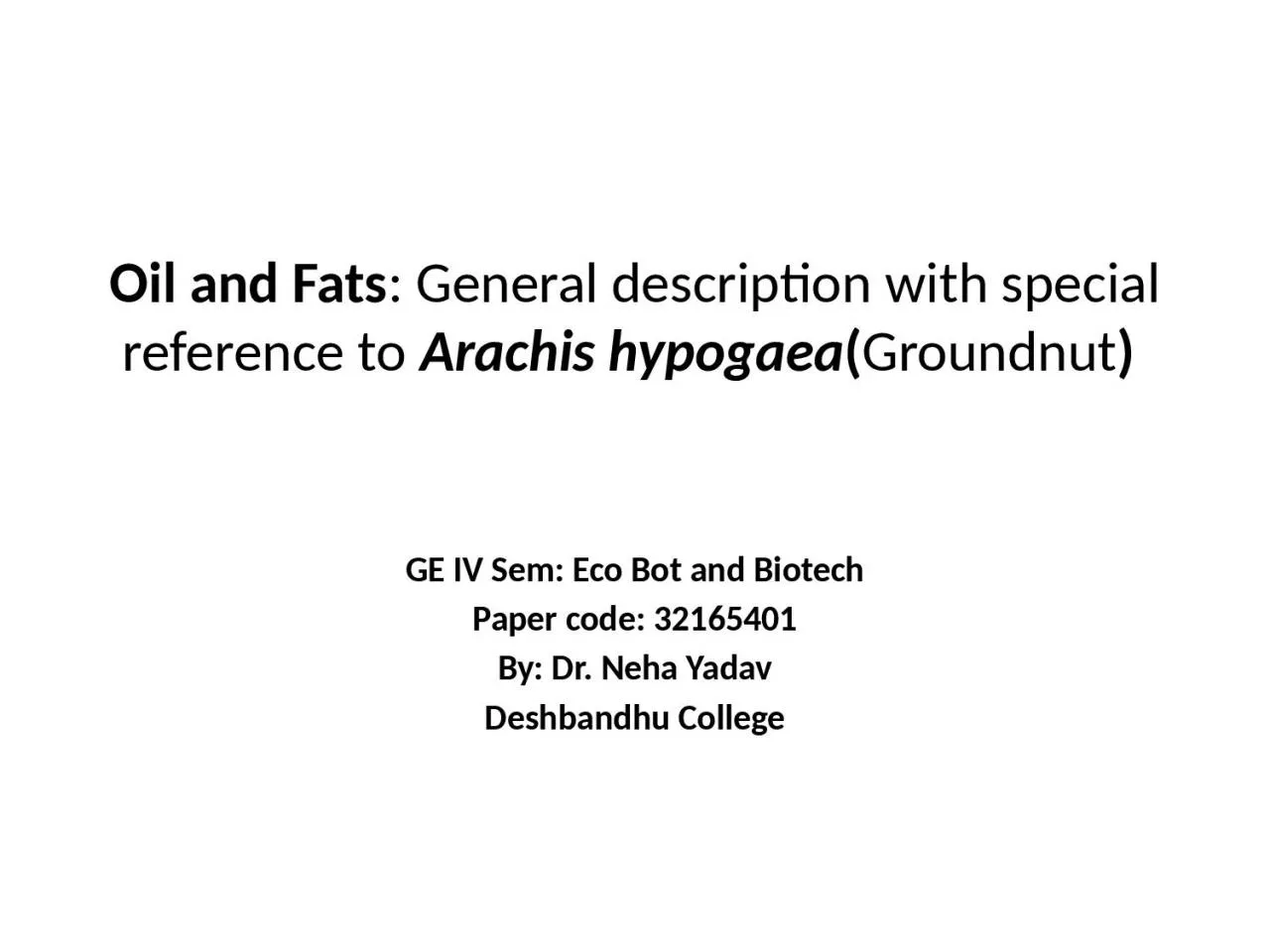/


Arachis hypogaea Groundnut GE IV Sem Eco Bot and Biotech Paper code 32165401 By Dr Neha Yadav Deshbandhu College Oil Fats and Waxes ID: 920710
Download Presentation The PPT/PDF document "Oil and Fats : General description with..." is the property of its rightful owner. Permission is granted to download and print the materials on this web site for personal, non-commercial use only, and to display it on your personal computer provided you do not modify the materials and that you retain all copyright notices contained in the materials. By downloading content from our website, you accept the terms of this agreement.
Slide1
Oil and Fats: General description with special reference to Arachis hypogaea(Groundnut)
GE IV
Sem
: Eco Bot and Biotech
Paper code: 32165401
By: Dr. Neha Yadav
Deshbandhu College
Slide2Oil, Fats and Waxes
Arachis
hypogaea
L.
Like Carbohydrates , Fats and
Oils contain only C, H and O
Though the proportion of three is
different
Have a relatively low percentage
of
Oxygen
Oils are liquid at room temperature
Fats are solid or nearly solid
Slide3Vegetable oil and Fats are triglycerides of complex organic fatty acidsNaturally occurring fats are usually mixtures of triglycerides of various fatty acids with a general formula
Slide4Fatty acids TypesFatty Acids are of two principal kinds: Saturated and UnsaturatedCommon saturated fatty acids in fats are Palmitic (abundant in vegetable fats) and Stearic acidCommon unsaturated fatty acids in fats are Oleic acid (one double bond)
Linoleic (two
double bond
) Linolenic (three double bond)Q. Differentiate between Saturated and Unsaturated Fatty acids?
Slide5How vegetable oils is different from essential oils (volatile oils/ethereal oils)?They do not volatilise at room temperatureThey cannot be distilled without being decomposedLeave a permanent greasy stain on paperBeing glycerides they form soap with alkali
Lack strong taste and
odour
of essential oils
Become rancid on long exposure to airEx: coconut oil, palm oil, soybean oil, olive oil etc.
Slide6Classification of Vegetable oils(Depends on the ability to absorb Oxygen from atmosphere)Three types:
Non-drying oils
- Remain liquid at room temperature, incapable of forming elastic films
(
they do not react with atmospheric oxygen),
Glycerides of saturated acids and oleic acid with little or no linoleic and linolenic acid, iodine number less than 100, never undergo Oxidation to form a fil and hence not used in paints and varnishes, useful in manufacturing of soaps, as lubricant and as food, these oils are found notably in plants of tropical regions. Example : Groundnut, Palm, Olive, Almond oil etc.
Slide72. Semi-drying oils- Intermediate between Drying and non-drying oils, characteristic in having linoleic and saturated acids, absorbs atmospheric oxygen slowly, produces soft film even after long exposure to air (never form a tough elastic film like Drying oils), iodine number lies between 100-130. Example: cootonseed sesame, corn oil etc.
Slide83. Drying oils: These oils are fairly rich in Glycerides of unsaturated fatty acids, particularly Linoleic and Linolenic acids
with few oleic
compounds, such oils readily absorb oxygen on exposure to air and form a tough, elastic and resistant film, thus important in paint and varnish industries, have high iodine number, usually more than 130. Example: temperate plants like Linseed, safflower,
soyabean
etc
included in this category.
Q. Differentiate between the tree types of vegetable oils?
Q. Write short note on drying oil or semi-drying or Non-drying oil
Slide9Location of oil in plant cells and methods of obtaining oils (For 1Mark Q’s)
Vegetable oil and fats
are located in the form of small insoluble oil droplets within the plant cells. Occur predominantly in
seeds
, mostly in endosperm and cotyledons.
In case of
cereals
, fat occurs almost exclusively in
embryo
Olive oil
and
palm oil
are examples where oil is obtained from
Fleshy pericarp of Fruit
Sometimes oils and fats are also extracted from roots, stems and foliage.
Methods of obtaining oils
1.Rendering
2.Mechanical Expression
3.Solvent Extraction
Slide10Utilization of Vegetable Oils and Fats
As food (concentrated reserve of energy as they contain very little oxygen, have high caloric value, have a role in satiety value of food, delays onset of hunger as fats retard the rate at which food leaves the stomach, adds
flavour
to food, acts as solvent for fat soluble vitamins, many oils are being used as cooking oil, residue left after extraction of oil called as oil-cake serves important livestock feed)
For industrial purpose (employed in non-edible products such as Paints and Varnishes and Lacquer, soaps, detergents, synthetic
fibres
, polishes, candles, cosmetics
etc
)
In Pharmaceuticals (Fixed oils and fats are used for their soothing properties)
Slide11Refer: Economic Botany in the Tropics, Fourth edition by S.L. Kochhar (2012)